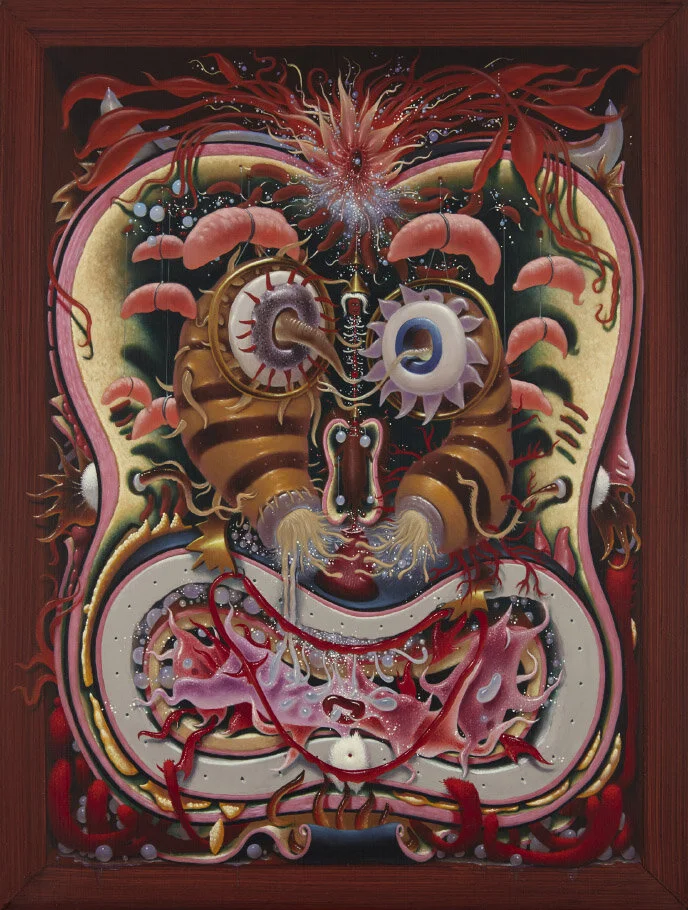Luc Waring
In his ‘Live Painting Exhibition’, artist Luc Waring’s new billboards seek “to spread peace and hope through [his] practice,” sparking discussions around injustice, migration and the refugee crisis.
In association with THE WHO GALLERY, a migrating ‘space without a space’, Waring’s large-scale billboards foster an exchange of ideas through a provocative moral inquiry. ‘Live Painting Exhibition’ is the artist’s story of “hope and compassion”. The project is dedicated to those who have lost their lives during treacherous boat-trips, fleeing the horrors of social injustice, political unrest and violent wars in search of stability. Located at a crossroad junction in the heart of Shoreditch, London, the outdoor hoardings are unmissable, inviting and confronting daily passers- by with a message of empathy and trauma; a bulletin often diluted by the delivery of mainstream media. Rather than exploiting human suffering for its shock-value, Waring commemorates an uncomfortable reality that has been part of his family’s history, calling on the viewers to sympathise with fellow human beings rather than succumbing to the numbing effect that results from a bombardment of endless information.
Whilst referencing our current socio-political mechanisms, Waring’s work is essentially “about being human.” Stirring emotions in connection with geopolitics, identity and spirituality, the artist’s process is heavily influenced by the machinations of his subconscious. With his home and studio being entangled, he ensures creativity is something that intrinsically seeps into all aspects of his life. Prompted by his practice of mindfulness, he attempts to make sense of the human condition as he combines art and life between moments of sleep and wakefulness. One of Waring’s major influences is John Heartfield, who the artist describes as “the godfather of graphics, collage and counter-propaganda”. Affected by his work’s examinations on bureaucratic conflicts through a groundbreaking use of typography, Waring’s large-scale billboard paintings employ a counterculture methodology, satirically playing with the power of advertising, commercialism and marketing to address capitalist regimes.
Interpreting the artist as a contemporary shamanic figure, he adopts an active political stance, aiming to channel sustainability through his practice. Having resided in Plum Village, a Buddhist monastery in France, the artist considered progressive solutions to global problems grounded in nonviolent activism. Applying these teachings to his work, Waring considers his paintings to hold a vibration which is filtered through a constant practice of regrounding and realigning with his principles. Wishing to act on this impulse for social change, he also volunteered in a refugee camp in Greece this year which he documented through analogue photography. Crossing waters, the artist sailed from the Caribbean to Portugal in 2017 as part of a fleet he described as consisting of “two rusty old tins”. Through these lived experiences, Waring has been emboldened to share peace in his paintings which exist as expressions of pure energy that transcend the physical dimension of the pressing moment.
At an intersection in the multicultural hub of East London, Waring’s billboards intend to interject positivity into the community surrounding their relationship with refugees. The artist directs the viewer towards what is constantly presenting itself around them through what he considers to be the most commonly viewed phenomena in our environment; advertising. Interrupting the slew of placard broadcasts, accessibility is prioritised as the overt display cultivates an immediate dialogue with all onlookers. Waring infuses ‘high’ and ‘low’ attributes of art as he mixes classical oil-based paints with urban spray paints on his announcements, while also employing a combination of interior materials in an exposed exteriority. Working as a Creative Director for various brands alongside his practice, the artist considers publicised panels to be a ‘ready-made’ of today which can be redirected towards a path of reconciliation. Integrating symbols from documentaries, trends and streets, he recontextualises everyday motifs to create new connections.
Working with concepts of authenticity, duality and propaganda, Waring developed his two billboard paintings over the course of two days. As he conceived these with a spontaneous approach, he teased out his inner-self in a revealing process where he ‘followed the painting’ in what he found to be a battling process. Presenting his message in a composition, language and style that could be easily understood, the artist created an asymmetric design that consisted of the union of a textual and a visual piece. To the left, Waring presents three ambiguous figures crammed together in a boat that appears untied to any specific location, situation or period. To the right, he reaches for the sensitivity of the observer in direct writing as he reminds them of the precarities of migration and the responsibility of the community to help. Despite not interpreting the public painting process as a performance, the artist intends to delve into performative art in the future by placing a soup kitchen in a London gallery.
Pursuing hope, he treats his work as an extension of his sketchbook as he employs a process of “continual automatic drawing” to honour refugees lost at sea. Through his ‘Live Painting Exhibition’ in Shoreditch, Waring commemorates all those who have set out on voyages to cross the English Channel in search of compassion. This work acts as a collective prayer for all the lives endangered by the necessity of migrant channel crossings.
gallery The WHO Gallery thewhogallery.com
gallery collaborator Outside The Zone
photos Charley Shillader
videos YDM Media
words VANESSA MURRELL
What to read next



















